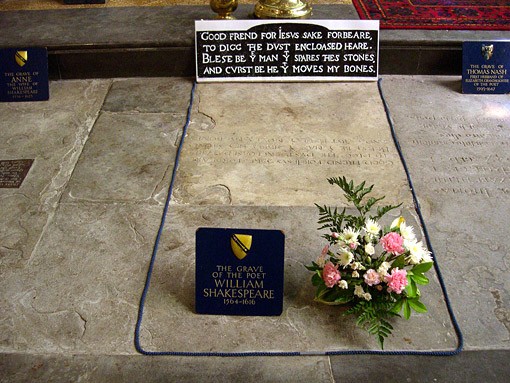
So stoned he doesn’t realize his quill is nowhere near the paper.
There is brand new evidence that Shakespeare was a pothead! This exciting story has appeared on the websites of TIME, the Los Angeles Times, CNBC, the Today Show, CNN, and many more outlets. And the brand new evidence is only fourteen years old! And it’s really weak evidence.
Francis Thackeray, Phillip Tobias Chair in Paleoanthropology at the Evolutionary Studies Institute, University of the Witwatersrand, Johannesburg, South Africa, recently published a short piece called “Shakespeare, plants, and chemical analysis of early 17th century clay ‘tobacco’ pipes from Europe” in the South African Journal of Science. But this isn’t the first time Thackeray has written about the topic. Oh, far from it. His one-page piece in the “Scientific Correspondence” section includes twelve end notes, nine of which cite nine different writings authored or co-authored by Thackeray.
Thackeray’s most recent missive responds to Mark Griffiths’ article in Country Life, which argues that a portrait of Shakespeare, made during his lifetime, appears on the title page of John Gerard’s Herbal. Thackeray questions the identification (as do I) and suggests the portrait may represent Francis Drake. He also uses the publicity generated by Griffiths’ article to reintroduce the subject of Shakespeare’s alleged drug use: “An appeal is made to the Shakespearean community to give attention to articles that were published more than a decade ago and which were largely criticised by Shakespeare scholars at that time. Chemical analyses of residues in early 17th century clay ‘tobacco pipes’ have confirmed that a diversity of plants were smoked in Europe. Literary anayses and chemical science can be mutually beneficial, bringing the arts and the sciences together in an effort to better understand Shakespeare and his contemporaries.”
Research into the substances people used medicinally and recreationally in Shakespeare’s time is useful and interesting. Collaboration and cooperation between the sciences and the humanities and arts are worthwhile goals. But there are very good reasons why the “Shakespeare community” greeted Thackeray’s writings with skepticism.
As I mentioned, Thackeray has written extensively on the topic of Shakespeare’s interest in and use of mind-altering drugs. The primary article—the scientific basis for his hypotheses—is “Chemical analysis of residues from seventeenth-century clay pipes from Stratford-upon-Avon and environs,” co-written with N.J. van der Merwe and T.A. van der Merwe and published in the South African Journal of Science. Thackeray and his colleagues used gas chromatography mass spectrometry to analyze the residue of 24 pipe bowl and stem fragments borrowed from the Shakespeare Birthplace Trust. Thackeray et al. say that “[o]n the basis of style, shape and size, all of the pipe bowl samples in this study probably date to the 17th century” (Thackeray et al., “Chemical analysis” 19). There is no citation given for the dating, which also doesn’t account for the fragments of pipe stems.
Four of the pipe fragments come from the garden of New Place, the home Shakespeare purchased in 1597. Seven come from Shakespeare’s Birthplace. Others come from Shakespeare Birthplace Trust properties with no direct association with Shakespeare, such as Harvard House, built by the grandfather of Harvard University’s benefactor. Several fragments were found in other towns completely.
The authors admit that they cannot “assume that any of the bowls and stems were from pipes used by Shakespeare” (Thackeray et al., “Chemical analysis” 21), but let’s consider just how likely it is that Shakespeare had anything to do with the pipes. The bowls “probably date to the 17th century.” That’s a hundred years, according to my calculations. Shakespeare died in 1616, so he was alive and possibly smoking for 15% of the 17th century. Additionally, most of the pipe fragments derive from places that have no direct association with Shakespeare, so I will consider only the ones that come from New Place or the Birthplace. The Birthplace remained in Shakespeare’s family, and he inherited it when his father died, but he spent most of his adult life elsewhere. He could have dropped a pipe on a visit to his family, but the chances seem rather remote. That leaves New Place, which Shakespeare bought in 1597. At that time, Shakespeare was still spending most of his time working in London. He seems to have largely retired to Stratford around 1610, so it may have been his primary residence for only six years. Even during his residence, he was surely not the only person to visit his garden. While it’s possible that one or more of the pipe fragments was used by Shakespeare, it seems statistically unlikely.
So, what chemicals did they find in the pipes? Lots. Oddly, only one sample had definite traces of nicotine. Some of the chemicals may have come from contamination from surrounding soil or from preservation practices. For instance, naphthalene, the main ingredient in mothballs, may have been used to control insects. The two chemicals that have garnered the most interest, though, are cocaine and cannabis. The cocaine was found in an unwashed pipe stem from Harvard House and a pipe bowl from the town of Abingdon. Thackeray et al. point out that the pipe stem could not have been exposed to contamination and that the bowl is “consistent with a 17th-century date” (20). Presumably, though, the stem can’t be narrowly dated, and the bowl could have been contaminated. Regardless, neither derives from a location that has any association with Shakespeare.
And then there’s the cannabis: “Unequivocal evidence for Cannabis has not been obtained…. The results are suggestive but do not prove the presence of Cannabis” (Thackeray et al., “Chemical analysis” 20). Yup. All those headlines about Shakespeare’s marijuana use boil down to this: some pipes that may have been dropped possibly within a hundred years of Shakespeare’s lifetime might have cannabis in them. In his most recent article, Thackeray says that the original study “indicated Cannabis in eight samples” (Thackeray, “Shakespeare”). That wording is more ambiguous and less careful. Thackeray told Edward Delman of The Atlantic “that he has since revisited the data and believes the evidence for cannabis to be more substantial than before,” but he has not published his reevaluation in a peer-reviewed journal.
So, really, the scientific evidence that Shakespeare used drugs is pretty slim. The only way to be sure would to dig Shakespeare up and test his remains, but that would be insa…..wait, Thackeray suggested that? Yes, he did. Oh dear.

Shakespeare’s grave, with curse. The curse does not make exceptions for people who want to find out if he was a stoner.
The study itself is interesting. It suggests that European people were experimenting with cannabis and cocaine earlier than previously known. It adds to our knowledge and understanding of (probably) the 17th century, and knowledge is cool. Thackeray, however, is determined to tie the research to Shakespeare, as evidenced by his attempts to have the Shakespeare family exhumed, despite the curse on Shakespeare’s grave. Meh, he was probably stoned when he wrote it.
While the chemical analysis may be perfectly valid, it doesn’t really provide evidence that Shakespeare himself used cannabis or cocaine. To bolster his argument, Thackeray refers to possible drug references in Shakespeare’s poetry. Of course, literary analysis is not Thackeray’s field, but it was a poem that first got him interested in the topic of Shakespeare’s drug use. In many of his writings, Thackeray discusses Sonnet 76:
In Sonnet 76 Shakespeare writes about “invention in a noted weed” [l. 6]. In the same sonnet it appears that he would prefer not to be associated with “compounds strange” [l. 4], which can be interpreted, at least potentially, to mean “strange drugs” (possibly cocaine). (Thackeray, “Shakespeare”)
Stripped of their context, “invention in a noted weed” and “compounds strange” may seem like drug references, but, according to the Oxford English Dictionary, the earliest reference to “weed” meaning “marijuana” comes from 1929, and it was originally a US slang term. “Weed” was used to refer to tobacco in the early 17th century, and Thackeray notes that “tobacco” could refer to anything people put in their pipes and smoked. Still, it’s a step too far to say “weed” could mean “tobacco,” and “tobacco” could mean “cannabis;” therefore, “weed” could mean “cannabis” (as far as I know, Thackeray does not directly suggest this).
In Sonnet 76, Shakespeare is discussing the apparent monotony and staleness of his poetry and its theme (the young man he is addressing). The first eight lines are comprised of a series of questions: “Why write I still all one, ever the same, / and keep invention in a noted weed” (ll. 5-6). The Norton Shakespeare glosses the line as “and keep literary creativity in such familiar clothing.” This is the standard interpretation. There may be another reference to clothes or putting on clothing in the same sonnet: “So all my best is dressing old words new” (l. 11). “Strange compounds” is generally interpreted as a reference to novel ways of mixing words, including the use of neologisms, although it may also refer to compounds formed by apothecaries, physicians, or herbalists. The Norton glosses “compounds” as “stylistic or formal mixtures; compound words; elaborate medicines (with ‘methods,’ which also refers to both literary and medical treatments).” Thackeray acknowledges these interpretations, but also insists on a drug reference:
Sonnet 76 may relate to complex wordplay relating in part to drugs (compounds and “weed”), and in part to a style of writing, associated with clothing (“weeds”) and literary compounds (words combined to form one, as in the case of the word “Philsides” from Philip Sidney.) (Thackeray, “Shakespeare”)
While Shakespeare may have been alluding to medicinal compounds for poetic effect, there is no reason to think the reference shows that he “may have been aware of the deleterious effects of cocaine as a strange compound” or that he “preferred Cannabis as a stimulant which had mind-stimulating properties” (Thackeray, “Shakespeare”). The association between “strange compounds” and cocaine and “noted weed” and cannabis is non-existent.
Thackeray also notes that, in Sonnet 27, “Shakespeare refers to ‘a journey in my head’ [l.3], potentially associated with a ‘trip’ and ‘out of body travel’ in an altered state of consciousness” (Thackeray et al., “Chemical analysis” 21). Let’s look at the context of the “journey in my head:”
Weary with toil I haste me to my bed,
The dear repose for limbs with travel tired;
But then begins a journey in my head
To work my mind when body’s work’s expired;
For then my thoughts, from far where I abide,
Intend a zealous pilgrimage to thee,
And keep my drooping eyelids open wide,
Looking on darkness which the blind do see;
Save that my soul’s imaginary sight
Presents thy shadow to my sightless view,
Which like a jewel hung in ghastly night
Makes black night beauteous and her old face new.
Lo, thus by day my limbs, by night my mind,
For thee, and for myself, no quiet find.
The speaker is on a literal journey (“limbs with travel tired”). His travels have taken him away from from “thee.” The “journey in my head” clearly contrasts with the literal journey: the speaker’s literal journey takes his body away from his beloved; the journey in his head takes his thoughts back, so that he can see in his “imaginary sight” his beloved’s “shadow.” The “journey in my head” is the imagination. Many people are able to use their imaginations without drugs of any kind, particularly in bed at night when they are very tired but their brains won’t turn off. Thackeray leaps from “journey” to “trip,” “out of body travel,” and “an altered state of consciousness” without any real evidence. As in the case of “weed,” Thackeray seems to be evoking a very modern slang use of the word “trip,” which wasn’t used to mean a “hallucinatory experience induced by a drug” (OED) until the mid-twentieth century. In this case, however, Shakespeare hasn’t even used a word that has modern associations with drugs: he uses “journey,” not “trip.”
In several works, Thackeray suggests that phrase “tenth muse” in Sonnet 38 may refer to hemp. One of his articles (which I have not yet been able to access) is called “The Tenth Muse: Hemp as a Source of Inspiration for Shakespearean Literature?” Another is titled “Shakespeare, Hallucinogens and a Tenth Muse: New Light on the ‘Dark Lady’?” In the latter work, Thackeray says, “Perhaps the identify of the “Dark Lady” lies hidden within the texts of at least some of the sonnets, dedicated to ‘the only begetter of these ensuing sonnets,’ wishing the reader an ‘adventure’ reminiscent perhaps of ‘voyages’ which a poet may have had in his mind.” Okay, first of all, “the only begetter” comes from the printer’s dedication at the beginning of the sonnets. Shakespeare didn’t write it. The “only begetter” refers to someone called “Mr. W.H.” While there is a lot of debate about the identity of W.H., it’s possible that it’s a misprint for W.S. and refers to Shakespeare. It certainly has nothing to do with hemp, and Mr. W.H. is probably not the Dark Lady. Nor is the tenth muse. The tenth muse, the inspiration of Sonnet 38 and so many of the sonnets, is the same beloved referred to in Sonnets 76 and 27. It is probably a young man, not the Dark Lady. The Only Begetter, the Tenth Muse, and the Dark Lady are three different people (who may or may not have been real people). None of them is hemp!
Thackeray seems to be good at what he does: he has a long list of scientific publications to his name. However, the scientific evidence for Shakespeare’s cannabis use is very weak, and his literary analysis depends on cherry-picking phrases that seem to support a conclusion he has already reached. We may not use the scientific method in the humanities, but we try not to start with the conclusion and then torture the evidence to fit it.
References
- Thackeray JF, Van der Merwe NJ, Van der Merwe TA. Chemical analysis of residues from seventeenth century clay pipes from Stratford-upon-Avon and environs. S Afr J Sci. 2001;97: 19-21. http://reference.sabinet.co.za/webx/access/electronic_journals/sajsci/sajsci_v97_n1_a8.pdf
- Thackeray JF. Shakespeare, hallucinogens and a tenth muse. http://www.teachernet.co.za/shakespeare1.html
- Thackeray F. Shakespeare, plants, and chemical analysis of early 17th century clay ‘tobacco’ pipes from Europe. S Afr J Sci. 2015;111(7/8), Art. #a0115, 2 pages. http://dx.doi. org/10.17159/sajs.2015/a0115. http://www.sajs.co.za/sites/default/files/publications/pdf/SAJS%20111_7-8_Thackeray_Sci%20Corr.pdf
- Thackeray JF The tenth muse: Hemp as a source of inspiration for Shakespearean literature? Occasional Paper of the Shakespeare Society of South Africa.
- All quotations from Shakespeare are from The Norton Shakespeare. Gen. ed. Stephen Greenblatt. New York: Norton, 1997.
- Image credits: 1. Shakespeare monument, Holy Trinity Church, Stratford-upon-Avon. Released into public domain by Tom Reedy. 2. “Shakespeare grave -Stratford-upon-Avon -3June2007” by David Jones – originally posted to Flickr as And curst be he yt moves my bones. Licensed under CC BY 2.0 via Commons – https://commons.wikimedia.org/wiki/File:Shakespeare_grave_-Stratford-upon-Avon_-3June2007.jpg#/media/File:Shakespeare_grave_-Stratford-upon-Avon_-3June2007.jpg











The presumptions of the referenced article (The Bard was a doper) are that 1) “Shakespeare” of Stratford-upon-Avon was a writer who achieved wide renown, and 2) his grave plot tells something about his state of mind and eventual artistic production.
These presumptions are yet to be established. Washington Irving recorded the statement of the Trinity Church sexton that nothing was under the slab in the Chancery hall when exhumed. This tends to weaken the article writer’s comments regarding a corpse identified inside or out of the hall as “Shakespeare”, holding, for thrills, a bit of marijuana. Such thoughts are post facto speculations, good copy for the minor periodical press which usually publishes any speculation about the historical “Shakespeare”.
There was a “Gulielmus Shakspere” recorded in the parish record. Neither he, nor his family, nor his neighbors, nor his townspeople ever considered him a writer. This further weakens any argument about “Shakespeare” and marijuana. The logical jump from a small-town money-lender to a prodigious genius of literature is entirely owing to the front matter of the First Folio. Coming from such a highly placed position of authority, few have questioned the fable that has ensued. The recent Washington Post article, “Five Myths About Shakespeare” is a paragon of fake factuality along those lines. The moral for skeptics is that belief has no time for investigation.
Thank you for pointing that out. I really should have corrected the post before it went up. After I discussed the the story on Virtual Skeptics last week, Jeb Card, an archaeologist, pointed out that stems could be dated quite narrowly. I made assumptions based on the article, which says the bowls were used for dating. The authors also say the pipe stem containing cocaine couldn’t have been contaminated and the bowl containing cocaine was from the 17th century. But, as I mentioned, everything they say about dating is oddly vague.
“Presumably, though, the stem can’t be narrowly dated. . .”
In fact archaeologists can date old English clay pipe stems to within about 30 years due to manufacturing changes. Holes in the stems got narrower through time due to improvements in making thinner wire that the clay was shaped around. We also find more stem fragments than bowls because men used to share pipes. They’d break off the end of the long stem, and drop it, to get a new mouthpiece after the previous smoker, so the stems are remarkably useful time markers in some sites. Here’s a link about their use in Colonial Jamestown, Virginia: http://www.nps.gov/archeology/afori/howfig_mar4.htm.
None of which changes Eve Siebert’s excellent analysis.